NVIDIA’s GeForce GTX 480 and GTX 470: 6 Months Late, Was It Worth the Wait?
by Ryan Smith on March 26, 2010 7:00 PM EST- Posted in
- GPUs
Image Quality & AA
When it comes to image quality, the big news from NVIDIA for Fermi is what NVIDIA has done in terms of anti-aliasing of fake geometry such as billboards. For dealing with such fake geometry, Fermi has several new tricks.
The first is the ability to use coverage samples from CSAA to do additional sampling of billboards that allow Alpha To Coverage sampling to fake anti-alias the fake geometry. With the additional samples afforded by CSAA in this mode, the Fermi can generate additional transparency levels that allow the billboards to better blend in as properly anti-aliased geometry would.
The second change is a new CSAA mode: 32x. 32x is designed to go hand-in-hand with the CSAA Alpha To Coverage changes by generating an additional 8 coverage samples over 16xQ mode for a total of 32 samples and giving a total of 63 possible levels of transparency on fake geometry using Alpha To Coverage.
In practice these first two changes haven’t had the effect we were hoping for. Coming from CES we thought this would greatly improve NVIDIA’s ability to anti-alias fake geometry using cheap multisampling techniques, but apparently Age of Conan is really the only game that greatly benefits from this. The ultimate solution is for more developers of DX10+ applications to enable Alpha To Coverage so that anyone’s MSAA hardware can anti-alias their fake geometry, but we’re not there yet.
So it’s the third and final change that’s the most interesting. NVIDIA has added a new Transparency Supersampling (TrSS) mode for Fermi (ed: and GT240) that picks up where the old one left off. Their previous TrSS mode only worked on DX9 titles, which meant that users had few choices for anti-aliasing fake geometry under DX10 games. This new TrSS mode works under DX10, it’s as simple as that.
So why is this a big deal? Because a lot of DX10 games have bad aliasing of fake geometry, including some very popular ones. Under Crysis in DX10 mode for example you can’t currently anti-alias the foliage, and even brand-new games such as Battlefield: Bad Company 2 suffer from aliasing. NVIDIA’s new TrSS mode fixes all of this.

Bad Company 2 DX11 Without Transparency Supersampling
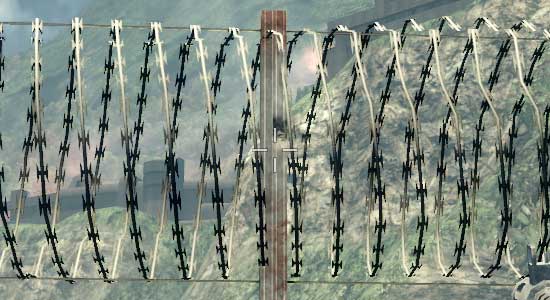
Bad Company 2 DX11 With Transparency Supersampling
The bad news is that it’s not quite complete. Oh as you’ll see in our screenshots it works, but the performance hit is severe. It’s currently super-sampling too much, resulting in massive performance drops. NVIDIA is telling us that this should be fixed next month, at which time the performance hit should be similar to that of the old TrSS mode under DX9. We’ve gone ahead and taken screenshots and benchmarks of the current implementation, but keep in mind that performance should be greatly improving next month.
So with that said, let’s look at the screenshots.

| NVIDIA GeForce GTX 480 | NVIDIA GeForce GTX 285 | ATI Radeon HD 5870 | ATI Radeon HD 4890 |
| 0x | 0x | 0x | 0x |
| 2x | 2x | 2x | 2x |
| 4x | 4x | 4x | 4x |
| 8xQ | 8xQ | 8x | 8x |
| 16xQ | 16xQ | DX9: 4x | DX9: 4x |
| 32x | DX9: 4x | DX9: 4x + AAA | DX9: 4x + AAA |
| 4x + TrSS 4x | DX9: 4x + TrSS | DX9: 4x + SSAA | |
| DX9: 4x | |||
| DX9: 4x + TrSS |
With the exception of NVIDIA’s new TrSS mode, very little has changed. Under DX10 all of the cards produce a very similar image. Furthermore once you reach 4x MSAA, each card producing a near-perfect image. NVIDIA’s new TrSS mode is the only standout for DX10.
We’ve also include a few DX9 shots, although we are in the process of moving away from DX9. This allows us to showcase NVIDIA’s old TrSS mode, along with AMD’s Adapative AA and Super-Sample AA modes. Note how both TrSS and AAA do a solid job of anti-aliasing the foliage, which makes it all the more a shame that they haven’t been available under DX10.
When it comes to performance, keep in mind that both AMD and NVIDIA have been trying to improve their 8x MSAA performance. When we reviewed the Radeon 5870 back in September we found that AMD’s 8x MSAA performance was virtually unchanged, and 6 months later that still holds true. The performance hit moving from 4x MSAA to 8x MSAA on both Radeon cards is roughly 13%. NVIDIA on the other hand took a stiffer penalty under DX10 for the GTX 285, where there it fell by 25%. But now with NVIDIA’s 8x MSAA performance improvements for Fermi, that gap has been closed. The performance penalty for moving to 8x MSAA over 4x MSAA is only 12%, putting it right up there with the Radeon cards in this respect. With the GTX 480, NVIDIA can now do 8x MSAA for as cheap as AMD has been able to
Meanwhile we can see the significant performance hit on the GTX 480 for enabling the new TrSS mode under DX10. If NVIDIA really can improve the performance of this mode to near-DX9 levels, then they are going to have a very interesting AA option on their hands.
Last but not least, there’s anisotropic filtering quality. With the Radeon 5870 we saw AMD implement true angle-independent AF and we’ve been wondering whether we would see this from NVIDIA. The answer is no: NVIDIA’s AF quality remains unchanged from the GTX200 series. In this case that’s not necessarily a bad thing; NVIDIA already had great AF even if it was angle-dependant. More to the point, we have yet to find a game where the difference between AMD and NVIDIA’s AF modes have been noticeable; so technically AMD’s AF modes are better, but it’s not enough that it makes a practical difference
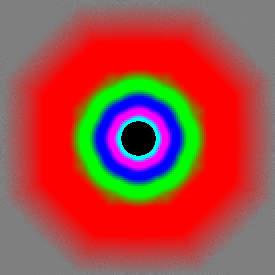
GeForce GTX 480

GeForce GTX 285
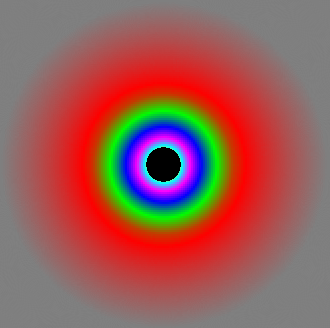
Radeon 5870


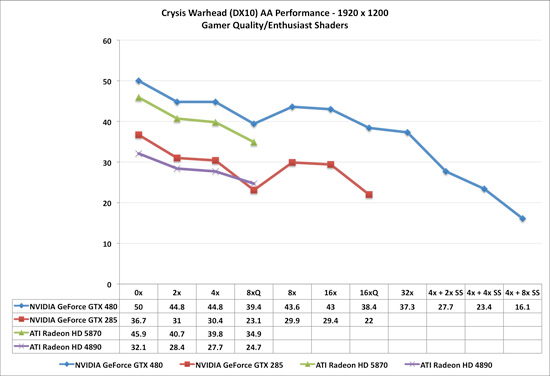
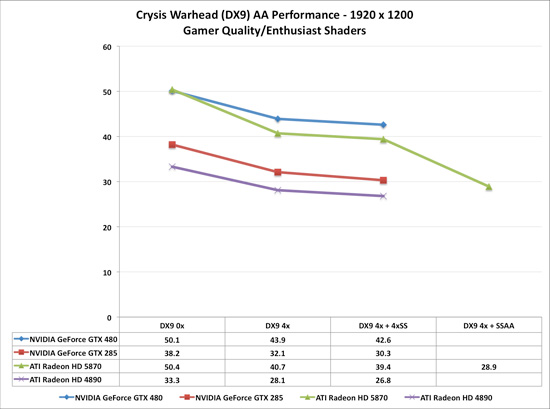








196 Comments
View All Comments
Headfoot - Monday, March 29, 2010 - link
Great review, great depth but not too long. Concise but still enough information.THANK YOU SO MUCH FOR INCLUDING MINIMUM FRAME RATES!!! IMO they contribute the most to a game feeling "smooth"
niceboy60 - Friday, August 20, 2010 - link
This review is not accurate , Badaboom GTX 400 series cards , are not compatible with GTX 400 series yet .However they already post the test resaultsI have a GTX 480 and does not work with badaboom , Badaboom official site confirms that
slickr - Sunday, March 28, 2010 - link
I thought that after the line-up of games thread, you would really start testing games from all genres, so we can actually see how each graphic cards performs in different scenarios.Now you have 80% first person shooters, 10% racing/Action-adventure and 10%RPG and RTS.
Where are the RTS games, isometric RPG's, simulation games, etc?
I would really like Battleforge thrown out and replaced by Starcraft 2, DOW 2: Chaos Rising, Napoleon Total War. All these RTS games play differently and will give different results, and thus better knowledge of how graphic cards perform.
How about also testing The Sims 3, NFS:Shift, Dragon Age Origins.
Ryan Smith - Monday, March 29, 2010 - link
Actually DAO was in the original test suite I wanted to use. At the high end it's not GPU limited, not in the slightest. Just about everything was getting over 100fps, at which point it isn't telling us anything useful.The Sims 3 and Starcraft are much the same way.
Hsuku - Sunday, March 28, 2010 - link
On Page 9 of Crysis, your final sentence indicates that SLI scales better than CF at lower resolutions, which is incorrect from your own graphs. CF clearly scales better at lower resolutions when video RAM is not filled:@ 1680x1050
480 SLI -- 60.2:40.7 --> 1.48
5870 CF -- 53.8:30.5 --> 1.76 (higher is better)
@ 1920x1200
480 SLI -- 54.5:33.4 --> 1.63
5870 CF -- 46.8:25.0 --> 1.87 (higher is better)
This indicates the CF technology scales better than SLI, even if the brute performance of the nVidia solution comes out on top. This opposes diametrically your conclusion to page 9 ("Even at lower resolutions SLI seems to be scaling better than CF").
(Scaling ability is a comparison of ratios, not a comparison of FPS)
Ryan Smith - Monday, March 29, 2010 - link
You're looking at the minimums, not the averages.Hsuku - Tuesday, March 30, 2010 - link
My apologies, I was looking at the wrong graphs.However, even so, your assertion is still incorrect: at at the lowest listed resolution, CF and SLI scaling are tied.
Ryan Smith - Wednesday, March 31, 2010 - link
Correct. The only thing I really have to say about that is that while we include 1680 for reference's sake, for any review of a high-end video card I'm looking nearly exclusively at 1920 and 2560.Hrel - Thursday, September 2, 2010 - link
I get that, to test the card. But if you don't have a monitor that goes that high, it really doesn't matter. I'd really like to see 1080p thrown in there. 1920x1080; as that's the only resolution that matters to me and most everyone else in the US.Vinas - Sunday, March 28, 2010 - link
It's pretty obvious that anantech was spanked by nVIDIA the last time they did a review. No mention of 5970 being superior to the 480 is a little disturbing. I guess the days of "trusting anandtech" are over. Come on guys, not even a mention of how easily the 5870 overclocks? The choice is still clear, dual 5870's with full cover blocks FTW!